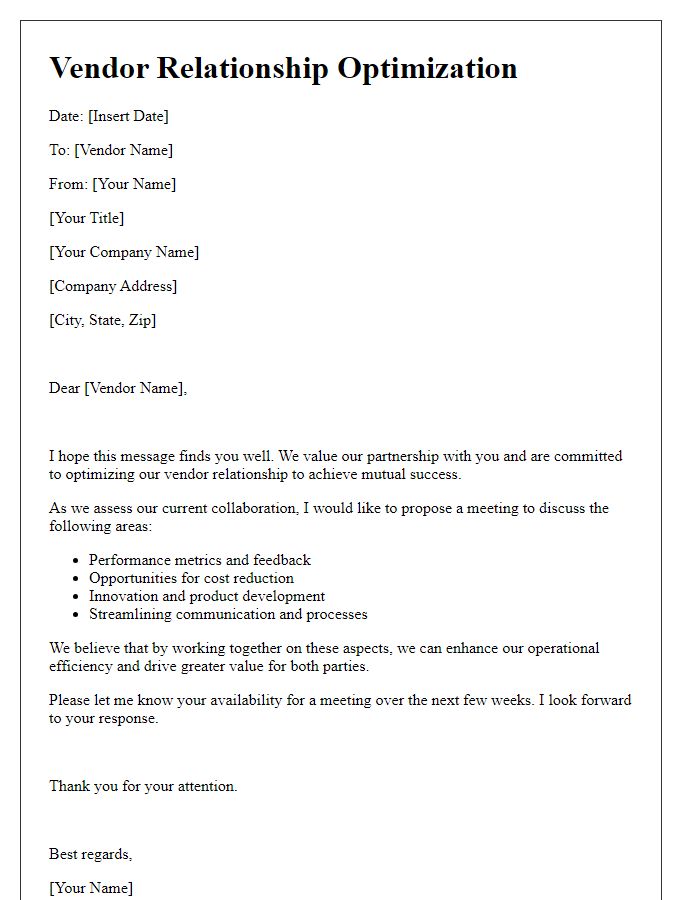Are you looking to enhance the efficiency of your supply chain? Understanding the current challenges and opportunities in your operations can significantly improve performance and reduce costs. In this article, we'll explore key strategies and insights for conducting a thorough supply chain optimization assessment. Join us as we dive deeper into the best practices that can transform your logistics process.

Supply chain process analysis
Supply chain process analysis plays a crucial role in optimizing efficiency and reducing costs within organizations. By examining each stage of the supply chain, from procurement (the acquisition of goods and services) to logistics (the management of the flow of resources), businesses can identify bottlenecks (areas causing delays) that impede smooth operations. Companies such as Amazon utilize advanced data analytics and forecasting techniques to optimize inventory levels, ensuring the right products are available at the right time while minimizing excess stock. Enhancements in transportation methods, including the use of autonomous vehicles and drone deliveries, further streamline logistics, thus accelerating delivery times. Furthermore, collaborations with suppliers and stakeholders can foster innovation, enhance responsiveness, and significantly improve overall performance, positioning the business competitively in a dynamic marketplace. Continuous improvement through Lean and Six Sigma methodologies further refines processes, leading to sustained operational excellence.
Data-driven decision making
Data-driven decision making is essential for optimizing supply chain processes in industries like retail and manufacturing. For instance, utilizing Key Performance Indicators (KPIs) such as Inventory Turnover Ratio (ITOR) can reveal inefficiencies in stock management. Advanced analytics tools such as predictive modeling can leverage historical data, forecasting demand fluctuations with greater accuracy, thus reducing excess inventory levels. Furthermore, integrating technologies like Internet of Things (IoT) devices can enhance real-time tracking of goods across various stages of the supply chain, improving transparency and reducing delays. Collaboration with data analytics platforms, such as Tableau or Power BI, allows for significant insights into logistics costs, supplier performance, and delivery times, ultimately driving more informed strategic decisions. Consequently, optimizing the supply chain not only enhances operational efficiency but also increases customer satisfaction by ensuring timely deliveries and reducing overall costs.
Stakeholder collaboration strategies
Supply chain optimization involves assessing stakeholder collaboration strategies to enhance efficiency and reduce costs in various sectors, such as manufacturing and logistics. Stakeholders, including suppliers, manufacturers, distributors, and retailers, play crucial roles in the supply chain ecosystem. Effective collaboration can lead to improved communication, data sharing, and resource management. Key metrics, such as lead times (often measured in days) and inventory turnover rates, can gauge collaboration effectiveness. Utilizing tools like supply chain management software enables seamless integration of stakeholder activities, ensuring timely deliveries and minimized disruptions. Engaging in regular stakeholder meetings can foster transparency and address potential bottlenecks, resulting in a more resilient supply chain.
Risk management frameworks
Risk management frameworks in supply chain optimization play a critical role in identifying, analyzing, and mitigating potential disruptions across logistics, inventory, and procurement processes. Notable frameworks, such as the ISO 31000 (International Organization for Standardization, 2018) and the COSO ERM (Committee of Sponsoring Organizations of the Treadway Commission, 2017), provide structured methodologies for risk assessment and control. In global supply chains, risks can stem from various factors like natural disasters in manufacturing hubs such as Southeast Asia or geopolitical tensions affecting trade routes in the Strait of Hormuz. The integration of advanced technologies like predictive analytics and big data can enhance real-time monitoring of supply chain vulnerabilities, allowing organizations to swiftly adapt their strategies. Given the increasing complexity of supply chains, continuous improvement of risk management approaches not only safeguards assets but also supports sustainable business growth.
Technology integration and innovation
Supply chain optimization assessment involves evaluating technology integration and innovation strategies in logistics and inventory management systems. Advanced technologies such as the Internet of Things (IoT) enable real-time tracking of shipments, enhancing visibility across warehouses, distribution centers, and retail locations. Machine learning algorithms can analyze historical data to forecast demand patterns, improving inventory turnover rates and reducing excess stock. Automation systems, including robotics, streamline warehouse operations, leading to increased efficiency and lower labor costs. Blockchain technology ensures transparency and security in transactions, facilitating smoother collaboration between suppliers, manufacturers, and retailers. Innovation in supply chain processes not only addresses challenges such as lead time reduction but also drives sustainability initiatives by minimizing waste and optimizing resource allocation. As organizations strive for a competitive edge, the incorporation of cutting-edge technologies becomes paramount.
















Comments